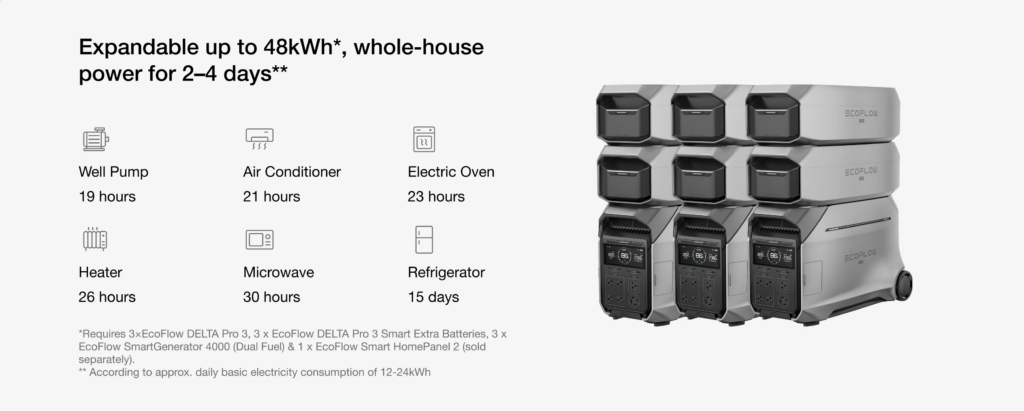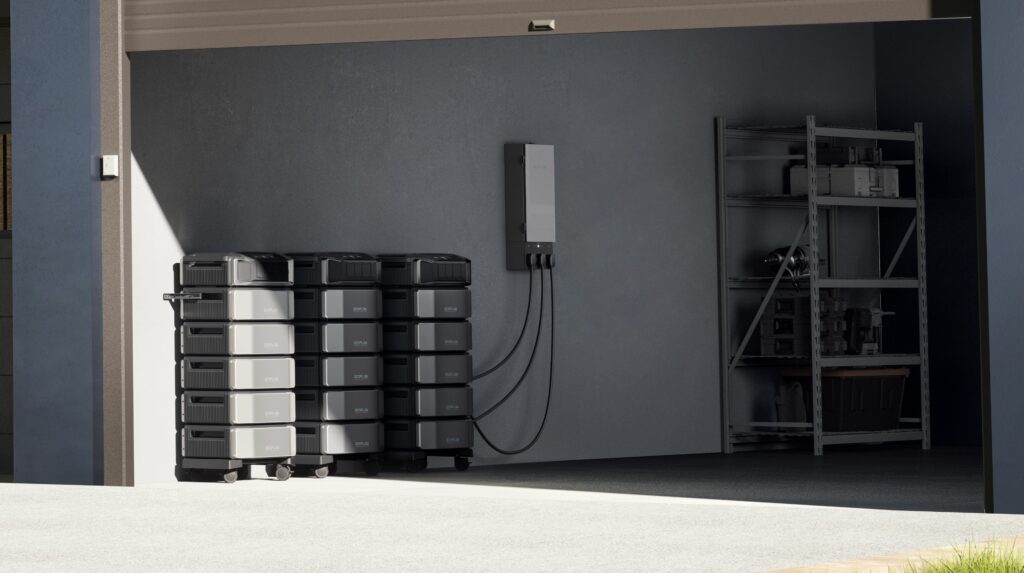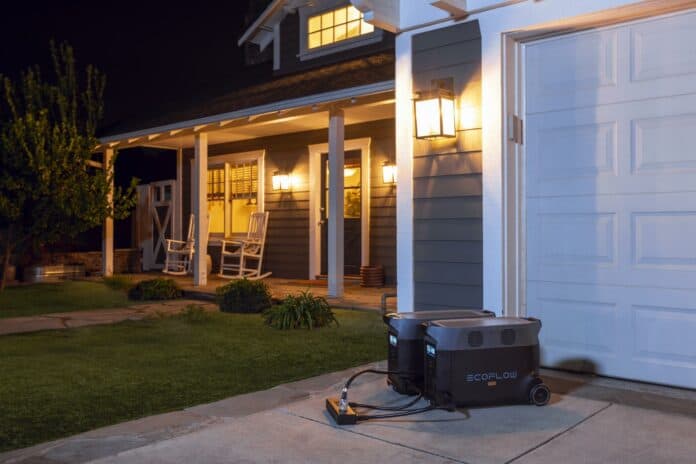Whole home battery backup systems are making their way into homes and replacing the noisy, pollutant-emitting fossil fuel generators that used to be standard.
Battery backup systems allow homeowners to weather even extended power outages and blackouts. With the right equipment, a whole home backup power solution can power an average household for at least a day and up to a week. If your battery backup system allows solar charging, you can add solar panels to generate clean, renewable electricity indefinitely.
Whole home battery backup systems typically cost between $3000 and $15,000 before installation. The prices vary widely depending on power output and storage capacity, home size, average electricity usage, and other factors.
Factors That Affect the Cost of a Whole House Battery Backup System
Many factors come into play when pricing out a whole-house backup system. These include:
- Battery size
- Power output capacity
- Installation
- Charging options
- Electricity Generation
Battery Size
Battery storage capacity is a significant factor in the cost of a whole-house backup system. Larger systems can store more electricity and provide backup power for longer, but they also cost more. Battery cost is often the largest share of the total system cost. Increasing the battery size or adding additional storage will almost always increase the overall cost of the system.
However, the cost per kilowatt-hour (kWh) of electricity storage decreases as the battery size increases. It may be more cost-effective to install a more extensive system to increase the backup time and reduce the need for supplemental backup power sources, such as a traditional fossil fuel generator.
Determining the optimal battery size for your home backup needs is based on additional factors like:
- Your average energy consumption,
- How many appliances you need to run during a blackout
- Their starting and running watts
- The duration of the outage you want to be prepared against
According to the U.S. Energy Information Administration, the average household uses 886 kWh of electricity per month (or about 30 kWh per day). To maintain this level of electricity consumption, you’d need a backup battery system size of 30 kWh just to run your house as normal for one day during a blackout.
However, you can take steps during a blackout to reduce energy usage, decreasing the battery storage capacity you need to install and maintain. To minimize your electricity usage, keep these tips in mind:
- Only open the refrigerator and freezer when necessary.
- Use air conditioning and heating systems as little as possible.
- Use led lights (which consume far less electricity than conventional light bulbs) and flashlights instead of your home’s lighting system.
Power Output Capacity
Batteries store power as DC electricity. You’ll need an inverter or an all-in-one battery backup solution like EcoFlow’s portable power stations to convert the energy stored in your battery into AC (household) electricity.
Battery storage capacity and power output capacity are not the same things. Storage capacity is the maximum amount of energy that your battery can hold at any given time. Storage capacity is typically measured in watt-hours (Wh) or kilowatt hours (kWh).
Power output capacity is the maximum amount of electricity your battery backup system can output at once. Power output capacity determines what kind of appliances you can run based on their electricity demands — usually measured in watts (W) or kilowatts (kW).
You can determine which appliances your battery backup system can run simultaneously by adding up the running wattage of each device you want to operate. One crucial thing to keep in mind is that many large appliances require more wattage to start up than they do to operate. This is called starting watts or surge power.
Here’s how to determine your power output needs step by step.
- Identify the wattage requirements of your appliances. Survey the starting and running wattage requirements of the appliances and devices you plan to plug into the generator. You can usually find the wattage requirements labeled on the appliance, but we’ve also compiled the starting and running watts of typical household appliances in the table below.
- Convert volts/amps to watts. If your appliance’s power requirements are in volts or amps, you can calculate an appliance’s running watts with this equation:
Volts (V) x Amps (A) = Watts (W)
- Count the running watts of your appliances. Add up the running watts of the appliances you plan to use — does the total exceed the running watts listed on your generator? If so, you should consider buying a generator with more output capacity.
- Factor in starting watt requirements. Identify the appliance with the highest starting wattage. Add that appliance’s starting wattage to the running wattage total.
- Calculate the sum. That final number is the total starting watts you need from your generator. As discussed above, to avoid overloading your generator, do not exceed its starting watts rating.
Starting and Running Watts of Typical Household Appliances
| Appliance | Rated (Running) Watts | Starting Watts |
| Dishwasher | 1300 | 1800 |
| Washing Machine | 1200 | 2300 |
| Refrigerator/Freezer | 700 | 2200 |
| Light Bulb | 60-75 | 0 |
| Microwave | 600-1000 | 0 |
| TV | 500 | 0 |
| Toaster | 900 | 0 |
| Vacuum | 1440 | 2500 |
| Coffee Maker | 1000 | 0 |
| Blender | 300 | 800 |
| Clothing Iron | 1500 | 0 |
| Dryer | 5400 | 7000 |
| Toaster Oven | 1200 | 0 |
| Curling Iron | 1500 | 0 |
| Space Heater | 2000 | 0 |
| Laptop | 50-300 | 0 |
| 20” Box Fan | 200 | 350 |
Installation
Depending on what kind of home battery backup system you buy, installation costs can add up quickly. Standalone portable power stations are plug-and-play. You’ll only have to pay minor installation costs if you want to integrate your whole house backup battery solution with your existing home wiring.
An electrician will need to connect the system to your home circuit board using a transfer switch or a solution like EcoFlow’s EcoFlow Smart Home Panel.
Generating Electricity During a Blackout
Keeping your whole home battery backup system topped up with power is easy when the grid is up and running. You can keep the system or portable power station fully charged with electricity from the grid to ensure your batteries are full when the lights go out.
But recharging from the grid isn’t an option during an extended outage. For added energy security, it’s best to opt for a solution with multiple charging options — including solar.
For example, by adding four rigid or portable 400W solar panels to EcoFlow’s EcoFlow DELTA Pro portable power station, you can generate up to 1600W of electricity simultaneously and fully recharge the battery in 2.8 to 5.6 hours (depending on environmental factors).
Another option with the EcoFlow DELTA Pro is adding a Smart Generator Dual Fuel. The Smart Generator operates on clean-burning, easy-to-store propane (or gasoline) to provide a last line of defense if your battery storage runs out.

If you’re looking for even more AC output, storage capacity, and fast charging options, consider EcoFlow’s DELTA Pro 3 + Smart Generator 4000 (Dual Fuel) hybrid inverter generator solution.
It’s highly expandable and offers unique DC fast charging of 4000W using gas or propane.
If you already have a gas or inverter generator, you can recharge EcoFlow DELTA Pro 3 with up to 3200W of input.

You could also opt for EcoFlow DELTA Pro Ultra. Starting with a 6kWh capacity, this powerful portable power station can reach a whopping 90kWh capacity, making it easy for it to grow with you if needed. You can add up to 42 400W Rigid Solar Panels to achieve 16.8kW of solar charging potential!
EcoFlow DELTA Pro 3 and DELTA Pro Ultra feature proprietary X-Core 3.0 tech architecture, providing industry-leading performance, safety, and intelligence.
X-Core 3.0 delivers the following benefits.
- X-Stream delivers record-speed charging — only 50 minutes
- X-Boost’s revolutionary soft-start algorithm supports up to 6000W of appliances and central HVAC systems with just one unit
- X-Link parallel expansion provides up to 21.6kW of output power and 90kWh of electricity storage
- X-Quiet volume minimization means whisper-quiet operation at an industry-best 30dB*
- X-Fusion outpowers the grid by providing up to 7000W of electricity output from a single AC outlet in bypass mode. Standard household plugs deliver only 1800W. Plug in EcoFlow DELTA Pro 3 or DELTA Pro Ultra and increase your output by close to 300%
- X-Guard is a protective triad of structure, material, and AI that keeps your home and family safe. It can even self-extinguish in the unlikely event of a fire.
Find out more about X-Core 3.0 here.
Which Whole House Battery Backup System Is Right for You?
There are various whole-house battery backup systems on the market to choose from. You can build one from scratch step-by-step. Or you can customize a setup that meets your family’s needs by selecting products from EcoFlow’s Smart Home Ecosystem.
When determining the best option, remember it’s about much more than just price.
Other significant factors to consider are the backup battery system’s expected lifespan, recharge time, ongoing maintenance requirements, battery chemistry and efficiency, and warranty.
Expected Lifespan
You may be tempted to choose the cheapest available whole house battery backup system, but what if you have to replace it in just a year or two?
A battery’s estimated lifespan is usually measured by cycle life. Each time you discharge and recharge the battery is called a cycle.
The number of cycles the battery will last without diminishing in efficiency is largely determined by its chemistry.
Battery Chemistry and Efficiency
The cheapest backup battery chemistry option is lead acid. The basic technology behind lead acid batteries is over 150 years old. These are the batteries you’ll find in TV remotes, flashlights, and old cars.
Lead acid batteries might get the job done, but not for long. Typically, lead acid batteries are only rated for a few hundred cycles, as opposed to new battery technology — like lithium iron phosphate (LFP/LiFePO4) — which can last for thousands of cycles without losing efficiency.
Lithium ion and LFP batteries have drastically reduced in price in recent years as the technology has become standard for solar generators, electric vehicles (EVs), and whole-home battery backup.
For example, the latest generation of lithium iron phosphate batteries in EcoFlow’s EcoFlow RIVER 2 Series and EcoFlow DELTA Pro portable power stations can last 6500 cycles — over a decade of average use.
Over the long term, you’ll save money by investing in modern battery technology like LFP.
Nickel-cadmium (Ni-Cad) batteries are also a better choice than lead acid, but they pale in comparison to LFP.
Maintenance
Lead acid battery systems require constant maintenance, such as adding distilled water every 2 to 4 weeks. Also, lead acid batteries should never be discharged below 50% capacity as it will lead to permanent damage. They must be stored in well-ventilated areas and may not function in extreme cold or heat.
Lithium iron phosphate batteries do not require regular maintenance, can be deeply discharged without harm, and operate in a much wider temperature range.
Warranty
Many cheap or low-quality battery backup systems will not include an extended warranty. This usually indicates that the manufacturer doesn’t stand behind their products.
Reputable companies will offer extended warranties for their products.
For instance, EcoFlow provides five-year warranties to their portable power stations, including the Delta PRO models in their Whole Home Backup Power Solution.
Final Thoughts
Whole home battery backup systems are an excellent way to prevent your family from being affected by power outages. With a big enough battery bank, you can even keep larger appliances running, such as refrigerators, heating and cooling systems, and more.
The Whole Home Backup Power Solution is a great way to get started on making your house more energy-resilient. The system is expandable, so you can always add more battery and output capacity down the line.
Best of all, solar panels are easily integrated into the system to generate clean, renewable power indefinitely.
*Under 2000W output
